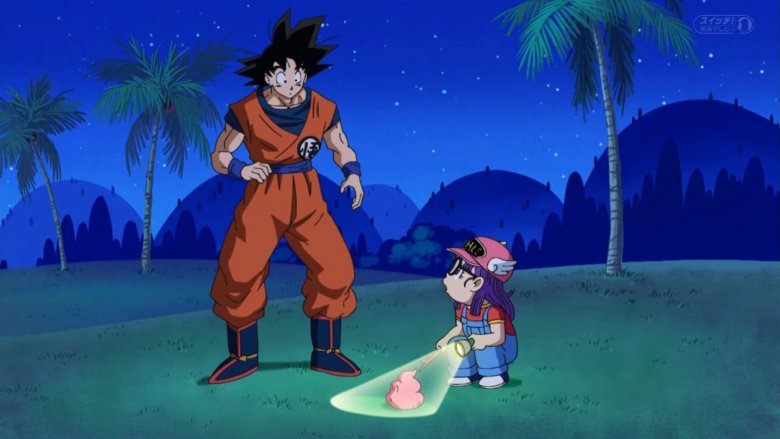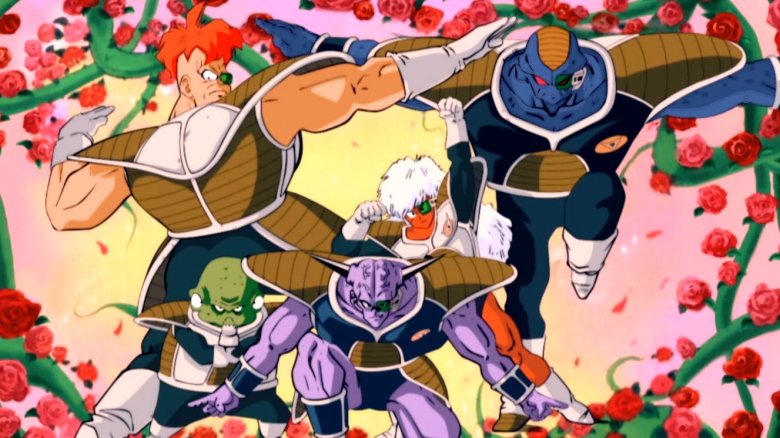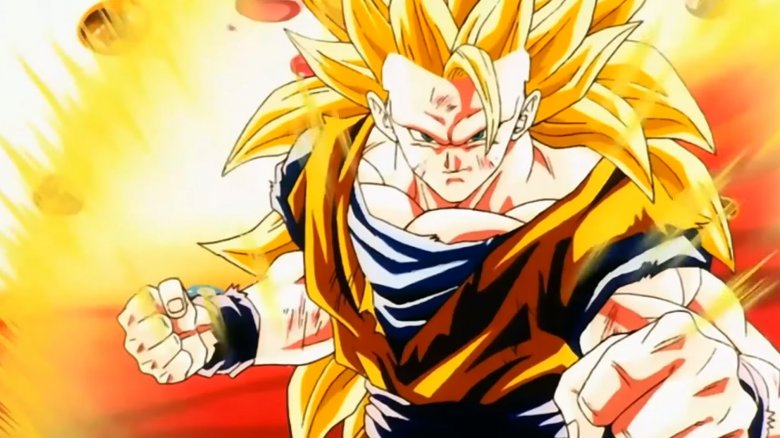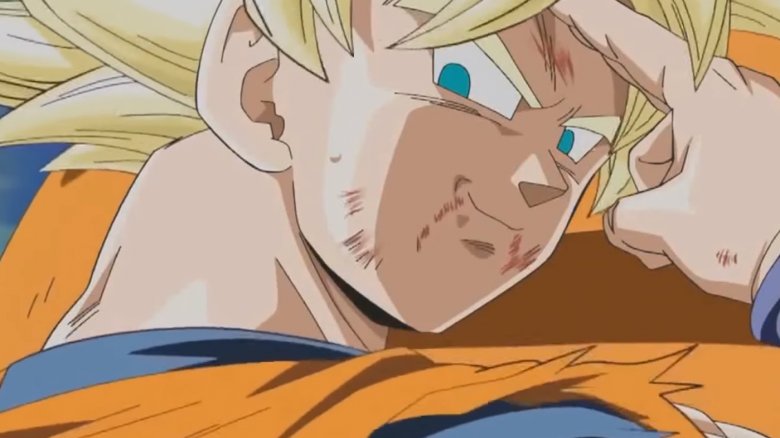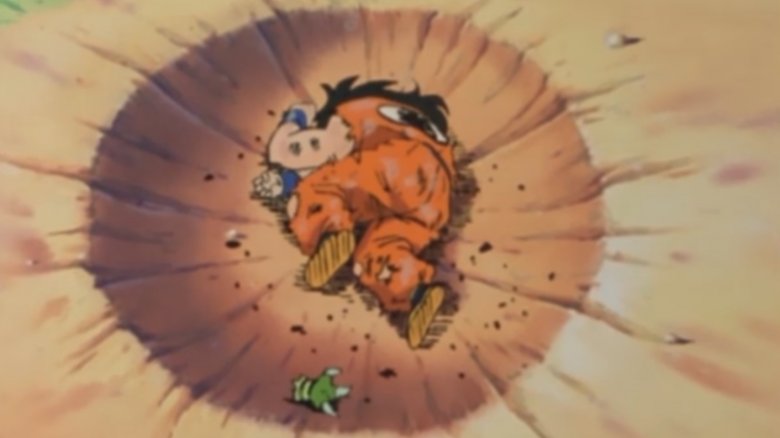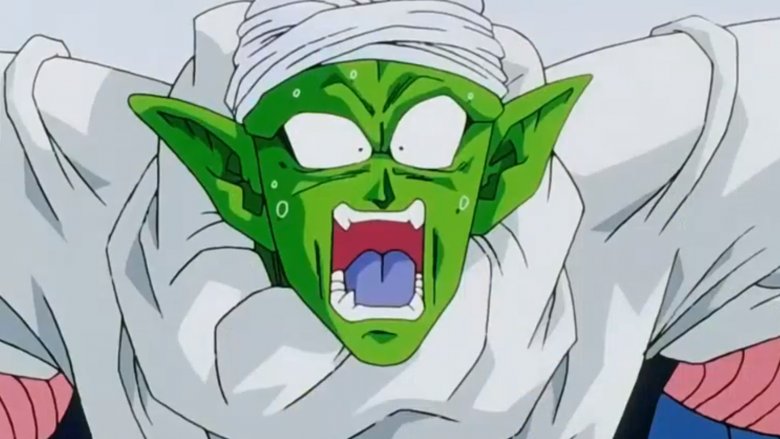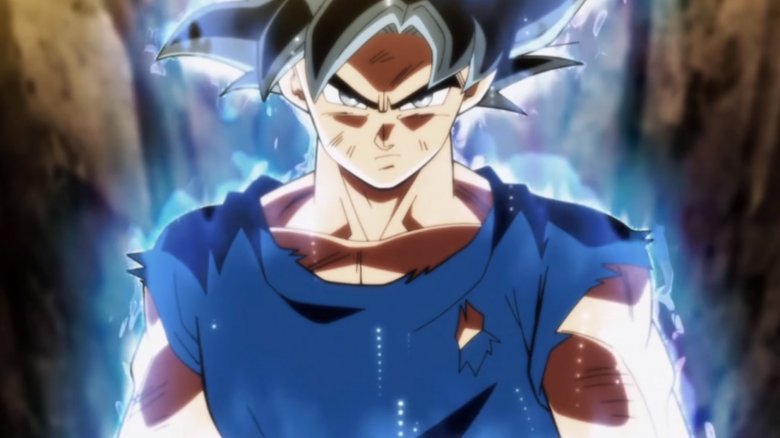The Untold Truth Of Dragon Ball Z
You don't need to be a Supreme Kai to know how much of an influence the Dragon Ball Z series has had on the world of anime, but there's a lot more to this franchise than just fast fights, spiky hair, and screaming at the top of your lungs to increase your power. The Saiyan tale of Goku and his friends branches back to 1984 and has had more twists and turns than Snake Way. With over $5 billion in franchise sales, DBZ is a cornerstone of Japanese animation and a cultural phenomenon.
Despite its impact, DBZ is only one part of this Broly-sized success story. The Dragon Ball franchise has spawned four anime series (five if you count Dragon Ball Kai), 19 movies, over 500 chapters of manga, nearly 100 video games, multiple Universal Studios rides, and all kinds of ridiculous memes and debates about power levels. Shenron has finally answered your wish, so chug your Hetap, because it's time to take a Grand Tour through the untold truth of Dragon Ball Z.
Toriyama journeys west
You might think Goku's story began with Akira Toriyama's first Dragon Ball manga chapter in a 1984 issue of Weekly Shonen Jump, but his origins start way before that. Toriyama, who'd already won multiple awards for his hit comedy manga Dr. Slump, wanted to do something drastically different for his next project. He turned to older folklore, in particular the 16th century novel Journey to the West, which featured the inspirations for Son Goku, the Power Pole weapon, the Flying Nimbus cloud, Bulma, Oolong the shapeshifting pig, Yamcha the desert bandit, the Ox King, and his castle on a fiery hill. Toriyama's editor, Kazuhiko Torishima, explained that Journey to the West was used because it was basically free intellectual property.
Toriyama's concept of gathering the seven dragon balls to summon Shenron the wish-granting Eternal Dragon was heavily inspired by the early 1800s novel Nansō Satomi Hakkenden, also known as The Eight Dogs Chronicles. Hakkenden's story depicted a princess who gave birth to eight crystal balls after getting freaky with a dog (we swear to Kami we're not making this up). The crystal balls then flew into the sky and scattered across the world, just like the dragon balls do after a wish, but became people instead. Considering the world of Dragon Ball features all kinds of anthropomorphic animals (including the leader of the world, King Furry), Hakkenden's connection to Toriyama's lore gets even more entwined (and gross).
Mixing together sexual humor and early '80s Jackie Chan-esque action-comedy, Toriyama finally made the manga...Dragon Boy, which served as a short prototype to the Dragon Ball story prior to the addition of Hakkenden and Journey's literary influences. A year later, Toriyama started a new Shonen Jump manga series starring some really pun-ny characters.
Name game
If you're a character in the Dragon Ball universe(s), chances are your name has some kind of pun to it. Most of Toriyama's nomenclature are food-based jokes and references. Gohan is the Japanese word for "rice." Krillin's Japanese name, Kuririn, is a mixture of Japanese word for "chestnut" (kuri) and the last syllable of shaolin (given that he was a monk prior to meeting Goku). His daughter, Marron, is named after the French word for chestnut. Chi-Chi is Japanese for "milk", but also a slang term for breasts in Spanish, which resulted in her character's name being changed for the South American dubs of the series. Even newer Dragon Ball Super characters like Beerus and Whis' names are puns (beer and whiskey, respectively).
Certain groups and families throughout the lore have specific themes to their naming. Bulma Brief's first name is a reference to bloomers, a Japanese name for school girls' gym shorts; and her last name refers to men's undies. Her children, Trunks and Bulla (pronounced "bra"), are obvious clothing references as well. Mr. Satan's first name is Mark (pronounced in Japan as "Maaku"), a phonetic anagram of akuma ("devil"). His daughter's name, Videl, is an anagram of "devil." Demon King Piccolo (the older one from the original series) is named after a musical instrument, as were his cronies, Piano, Tambourine, Cymbal, and Drum. Do magical spells such as "abracadabra" and "Bibbidi-Bobbidi-Boo" sound familiar to you? The spell-slinging group of DBZ baddies — Bibidi, Babidi, Majin Buu, and Dabura — all get their names from them. Most of Frieza's (refrigerator reference) soldiers were named after types of fruit, but his elite Ginyu Force were named after dairy products — Ginyu is a Japanese phrase for cow's milk, Burter is "butter," Guldo is Japanese for "yogurt," Jeice is Japanese for "cheese" (which also happens to sound a lot like the word "juice"), and Recoome is an anagram of the Japanese word for cream, "kurimu."
The food-based names go healthier when it comes to the members of the Saiyan race ("saiya" is an anagram of "yasai", Japanese for "vegetable"). Vegeta is the first part of "vegetable." Broly is broccoli. Goku's Saiyan name of Kakarot refers to carrots. Nappa is a type of cabbage. Raditz is radish. Caulifa is cauliflower, and who knows what sort of devious, disgusting pun is behind Kale's name.
Charging up the anime
About halfway through the original Dragon Ball manga series, readership started to dwindle, as did ratings for its anime counterpart, so Torishima and Toriyama decided to drastically change things, such as making Goku want to become the strongest person ever and enter the World Martial Arts Tournaments in an effort to appeal to young male readers. To further the anime's evolution away from Dr. Slump-like comedy, Torishima got rid of the show's original producer (who produced the anime for Dr. Slump) and hired Saint Seiya director Kouzou Morishita and scripter Takao Koyama to drastically change the anime to match the source manga's shift from comedy to action. As a result, the final arc of Dragon Ball (the Piccolo Jr. saga) was made, which featured the most intense fights of the series. Goku was growing up, and he was ready for a new hairstyle.
Trying to end at Z
Torishima's changes to the anime development team helped with setting up Dragon Ball's ending. The ratings and readership spiked during the action-filled final saga, so fans were dying to see a continuation of the story, especially since its villain, Piccolo Jr., was still alive. "So we decided to go with the different title and updated characters, with bigger proportions, and we had a meeting for this new title but we couldn't come up with anything good," Torishima said. "I went and asked Toriyama for his input and he answered immediately by saying 'Dragon Ball Z ... because this is last, nothing comes after this.'" It also helped that the Z in the logo looked an awful lot like the number two — given Toriyama's fondness for puns, we wouldn't put it past him.
DBZ was meant to be the end for Goku's story — multiple times, usually with him passing the torch. Initially, the Frieza saga was intended to be the final chapter of Dragon Ball Z, considering it was the franchise's longest fight (over 20 manga chapters long). Goku beats the strongest, most evil character in the universe and ascends to an unbeatable form. Of course, the Super Saiyan success story had to continue, so Toriyama just kept introducing more Western tropes to a story inspired by Asian folklore and martial arts movies. Goku's alien backstory, abnormal strength, and alien heritage were explained during the Saiyan saga, which heavily draws from the lore of Superman. Goku (Superman) landed on Earth as a baby and was raised like any other human. And he would eventually have to fight members of his nearly-extinct race (General Zod and his forces) trying to conquer Earth. The space adventures of Namek and intergalactic tyranny of Frieza's forces were largely influenced by Star Wars (the original manga also had some subtle references).
What does a franchise do when its creative team runs out of ideas? Go to space or time travel — and DBZ did both. Terminator 2: Judgment Day hit theaters in July 1991. By November that year, DBZ started a story arc featuring a badass guy going back through time, trying to prevent an apocalyptic future where cyborgs (who have metal endoskeletons) exterminated humanity. Did we mention that he's the son of one of DBZ's bad guys turned good? Because bad guys turning good happens a lot throughout the franchise. Krillin, Yamcha, Tien Shinhan, Piccolo, Vegeta, Androids #16, #17, #18, Majin Buu, Beerus, and even Frieza go from being Goku's rivals/enemies to inevitably joining his squad.
Needing a senzu bean
If you thought Goku's memory was shaky, Toriyama has a much higher power level. Remember Launch? Despite her prevalence throughout the original series, she was gone throughout a vast majority of DBZ because Toriyama simply forgot about her. By the time he remembered she was part of the team, Super Saiyan hairstyles would've looked weird next to her already-blonde look, so he chose to exclude her. Add a lackadaisical approach for his predominantly black and white manga series, and there have been some discrepancies, especially going from print to animated. One example would be Bulma's hair, which has been blue, green, and purple. This inconsistency has even carried on to Dragon Ball Super as well, considering that Trunks had purple hair throughout DBZ and early parts of Super, but his future form in DBS has blue hair. Vegeta was originally introduced in DBZ with brown-red hair and the ugliest color combination possible for his armor, which was drastically changed upon his arrival at Earth.
Want to know why the Super Saiyan form has blonde hair? Toriyama introduced it to save time so he and his team didn't have to spend as much time shading in dark hair on black and white manga panels. Meanwhile, Toriyama was getting bored with some of his characters, so he introduced transformations to keep things interesting, such as Super Saiyan 3. He intended for #19 and #20 to be the main villains of the Android saga, but Torishima told him to make them the decoys and introduce the other cyborgs and Cell. Luckily, adding transformations helped add finesse and lengthened fights so that there was a visible change to characters going to higher levels of power during their fights.
Rock the power
The English dubs of Dragon Ball Z didn't start until nine months after the Japanese animation ran its last DBZ episode on January 31, 1996. The English dub didn't end for another seven years. Funimation originally hired Saban Entertainment for DBZ's distribution in the West, and they hired Ocean Productions to dub the first two seasons of the anime until syndicated companies lost interest in the series. Unfortunately, Saban turned away from DBZ in order to focus on its Fox Kids programming (such as X-Men: The Animated Series). The show didn't catch any major success until its first two dubbed seasons played on Cartoon Network, where the series took off with its target audience.
After nearly two years, the show's popularity on Cartoon Network got Funimation enough traction to continue dubbing the rest of the series, but the original Ocean voice team was out of their price range, so they made their own studio and hired an all new cast. This is why the voices change halfway through the Namek saga and Vegeta's meme-worthy "over 9,000" line (which was a mistake from the manga's original line of 8,000) doesn't sound the way people remember it — it was said by Ocean's Brian Drummond (DBZ episodes 1-54) not Christopher Sabat (DBZ episodes 55-276, Dragon Ball Super, and every other English Vegeta role to date).
While most of the Ocean Productions' dub work for the series is mostly forgotten, we got the iconic "Rock the Dragon" theme song from it, which was done by Saban's Jeremy Sweet and Ron Wasserman — who also did the "Go Go Power Rangers" theme song.
Censorship and controversies
With DBZ originally intended for TV syndication, a lot of changes were made from the Japanese animation. All instances of death, heaven, and hell were altered. Vegeta wasn't "killing" Frieza's men — he was simply sending them to the "next dimension." There's a part of the series where Goku lands in hell and meets a pair of ogres. The characters' shirts reading "HELL" were partially censored to look like the letters "HFIL." One of the other dimensions Vegeta kept raving about was, in turn, called the "Home For Infinite Losers." Mr. Satan's name was changed to Hercule to avoid any religious backlash from viewers' families.
As would be expected, scenes of cigarettes, blood, alcohol, nudity, and middle fingers were all removed in converting the show from Japanese to English. Other weird changes were made, including the visible tears of Gohan disappearing during the Saiyan saga. A standout change happened when Mr. Popo, who is often regarded as a blackface stereotype, was given a hue change for The CW's Toonzai programming schedule.
A Grand Tour, evolution, gods, and beyond
Toriyama ended Dragon Ball Z's manga in 1995, but Toei Animation wanted to continue the series due to the widespread success of the anime. As a result, Dragon Ball GT ("Grand Touring") was created by Toei's staff without any input from Toriyama except for the series' name. GT kept Goku's story going, but it was met with negative reviews, failing to live up to its predecessor without Toriyama at the helm. Dragon Ball GT's final 1997 episode was the last time television viewers in Japan would get to see Goku and the gang for a long time (save a few specials and movies).
During this time, Dragon Ball Z was just starting to take off in North America with Funimation's dubs. The popularity of Dragon Ball with Western audiences resulted in James Wong's live-action Dragonball Evolution film, which was loosely (and we mean Super Saiyan 4-levels of loosely) based on the original Dragon Ball story. Evolution is regarded as a low point of the franchise, earning a 15 percent score on Rotten Tomatoes.
For the series' anniversary, Funimation went back and revised DBZ's episodes, updating the animation, redubbing the audio, and whittling the series down to match the source manga as close as possible, resulting in 2009's Dragon Ball Kai series. This helped Toei Animation test the waters for interest in the franchise and led to Toriyama returning to the helm for 2013's Dragon Ball Z: Battle of Gods movie — the first Japanese film to ever screen in IMAX. Next, Goku and the gang went at it in Toriyama's official sequel to DBZ, Dragon Ball Super.
Unfortunately, Hiromi Tsuru, the voice actress who had voiced Bulma's character since episode one of the Japanese Dragon Ball series, died in late 2017. Goku's voice actress, Masako Nozawa, has also been voicing her character for the past 32 years. She's over 80 years old, and still does the best "Kamehameha" on the planet.
